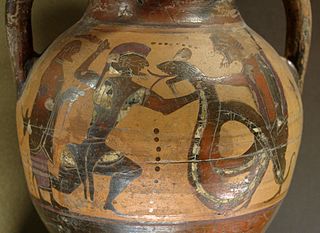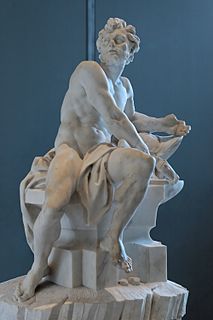Related Research Articles

Ares is the Greek god of courage and war. He is one of the Twelve Olympians, and the son of Zeus and Hera. The Greeks were ambivalent toward him. He embodies the physical valor necessary for success in war but can also personify sheer brutality and bloodlust, in contrast to his sister, the armored Athena, whose martial functions include military strategy and generalship. An association with Ares endows places and objects with a savage, dangerous, or militarized quality.

Hera is the goddess of women, marriage, family and childbirth in ancient Greek religion and mythology, one of the twelve Olympians and the sister and wife of Zeus. She is the daughter of the Titans Cronus and Rhea. Hera rules over Mount Olympus as queen of the gods. A matronly figure, Hera served as both the patroness and protectress of married women, presiding over weddings and blessing marital unions. One of Hera's defining characteristics is her jealous and vengeful nature against Zeus' numerous lovers and illegitimate offspring, as well as the mortals who cross her.

Heracles, born Alcaeus or Alcides, was a divine hero in Greek mythology, the son of Zeus and Alcmene, and the foster son of Amphitryon. He was a great-grandson and half-brother of Perseus, and similarly a half-brother of Dionysus. He was the greatest of the Greek heroes, the ancestor of royal clans who claimed to be Heracleidae (Ἡρακλεῖδαι), and a champion of the Olympian order against chthonic monsters. In Rome and the modern West, he is known as Hercules, with whom the later Roman emperors, in particular Commodus and Maximian, often identified themselves. The Romans adopted the Greek version of his life and works essentially unchanged, but added anecdotal detail of their own, some of it linking the hero with the geography of the Central Mediterranean. Details of his cult were adapted to Rome as well.

Hephaestus is the Greek god of blacksmiths, metalworking, carpenters, craftsmen, artisans, sculptors, metallurgy, fire, and volcanoes. Hephaestus's Roman counterpart is Vulcan. In Greek mythology, Hephaestus was either the son of Zeus and Hera or he was Hera's parthenogenous child. He was cast off Mount Olympus by his mother because of a congenital impairment or, in another account, by Zeus for protecting Hera from his advances.

Thrace or Thrake is a geographical and historical region in Southeast Europe, now split among Bulgaria, Greece, and Turkey, which is bounded by the Balkan Mountains to the north, the Aegean Sea to the south, and the Black Sea to the east. It comprises southeastern Bulgaria, northeastern Greece, and the European part of Turkey. The region's boundaries are based on that of the Roman Province of Thrace; the lands inhabited by the ancient Thracians extended in the north to modern-day Northern Bulgaria and Romania and to the west into the region of Macedonia.
In Greek mythology, Apate was the personification of deceit. Her mother was Nyx, the personification of night. Her Roman equivalent was Fraus. Her male counterpart was Dolos, daemon of trickery, and her opposite number was Aletheia, the spirit of truth.

The Dacians were the ancient Indo-European inhabitants of the cultural region of Dacia, located in the area near the Carpathian Mountains and west of the Black Sea. They are often considered a subgroup of the Thracians. This area includes mainly the present-day countries of Romania and Moldova, as well as parts of Ukraine, Eastern Serbia, Northern Bulgaria, Slovakia, Hungary and Southern Poland. The Dacians spoke the Dacian language, which has a debated relationships with the neighbouring Thracian language and may be a subgroup of it. Dacians were somewhat culturally influenced by the neighbouring Scythians and by the Celtic invaders of the 4th century BC.

The Thracians were an Indo-European speaking people, who inhabited large parts of Eastern and Southeastern Europe in ancient history. Thracians resided mainly in the Balkans, but were also located in Asia Minor and other locations in Eastern Europe.

The Cicones or Ciconians were a Homeric Thracian tribe, whose stronghold in the time of Odysseus was the town of Ismara, located at the foot of mount Ismara, on the south coast of Thrace. They are mentioned in book two of the Iliad as having joined the war on the side of the Trojans, led by Euphemus. In book nine of Homer's Odyssey, Odysseus and his men take Ismara by surprise and slay most of the Ciconian men they come across, taking Ciconian women as slaves. Later Ciconian reinforcements arrive and attack the invading Achaeans, killing so many of them that Odysseus and his men are forced to flee in their ships. Six men of each of Odysseus' ships were killed:
When I had set sail thence the wind took me first to Ismarus, which is the city of the Cicons. There I sacked the town and put the people to the sword. We took their wives for sexual pleasure, service, and booty which we divided equitably amongst us, so that none might have reason to complain. I then said that we had better make off at once, but my men very foolishly would not obey me, so they stayed there drinking much wine and killing great numbers of sheep and oxen on the sea shore. Meanwhile the Cicons cried out for help to other Cicons who lived inland. These were more in number, and stronger, and they were more skilled in the art of war, for they could fight, either from chariots or on foot as the occasion served; in the morning, therefore, they came as thick as leaves and bloom in summer, and the hand of heaven was against us, so that we were hard pressed. They set the battle in array near the ships, and the hosts aimed their bronze-shod spears at one another. So long as the day waxed and it was still morning, we held our own against them, though they were more in number than we; but as the sun went down, towards the time when men loose their oxen, the Cicons got the better of us, and we lost half a dozen men from every ship we had; so we got away with those that were left.
The Twelve Labours of Heracles are a series of episodes concerning a penance carried out by Heracles, the greatest of the Greek heroes, whose name was later romanised as Hercules. They were accomplished at the service of King Eurystheus. The episodes were later connected by a continuous narrative.
Hercules and the Lost Kingdom is the second television movie in the syndicated fantasy series Hercules: The Legendary Journeys.
Cebrenii is the name of a Thracian tribe, they are mentioned by Polyaenus and Strabo.
Sycaeboae is the name of a Thracian tribe, which was mentioned by Polyaenus.

The history of Thracian warfare spans from the 10th century BC up to the 1st century AD in the region defined by Ancient Greek and Latin historians as Thrace. It concerns the armed conflicts of the Thracian tribes and their kingdoms in the Balkans. Apart from conflicts between Thracians and neighboring nations and tribes, numerous wars were recorded among Thracian tribes.

Hercules is a 2014 American action-adventure fantasy film starring Dwayne Johnson as the titular character. It is directed by Brett Ratner based on a screenplay written by Ryan J. Condal and Evan Spiliotopoulos. The film also stars Ian McShane, Rufus Sewell, Aksel Hennie, Ingrid Bolsø Berdal, Reece Ritchie, Tobias Santelmann, Joseph Fiennes, Peter Mullan, Rebecca Ferguson, Irina Shayk, Isaac Andrews, and John Hurt. It is based on Steve Moore's graphic novel Hercules, specifically The Thracian Wars limited series. Distributed jointly by Paramount Pictures and Metro-Goldwyn-Mayer, it was released on July 25, 2014. It is one of two Hollywood-studio Hercules films released in 2014, the other one being Lionsgate's The Legend of Hercules.

The Assyrian captivity is the period in the history of ancient Israel and Judah during which several thousand Israelites from the Kingdom of Israel were forcibly relocated by the Neo-Assyrian Empire. This is one of the many instances of the resettlement policy of the Neo-Assyrian Empire. The Kingdom of Israel was conquered by the Neo-Assyrian monarchs Tiglath-Pileser III and Shalmaneser V. The later Assyrian rulers Sargon II and his son and successor, Sennacherib, were responsible for finishing the twenty-year demise of Israel's northern ten-tribe kingdom, although they did not overtake the Kingdom of Judah. Jerusalem was besieged, but not taken. The tribes forcibly resettled by Assyria later became known as the Ten Lost Tribes.
References
- ↑ Polyaenus: Stratagems - BOOK 7 ,The generals of the Cebrenii and Sycaeboae, two Thracian tribes, were chosen from among the priests of Hera. Cosingas, according to the tradition of the country, was elected to be their priest and general; but the army took some objection to him, and refused to obey him. To suppress the rebelliousness that had taken hold of the troops, Cosingas built a number of long ladders, and fastened them one to another. He then put out a report, that he had decided to climb up to heaven, in order to inform Hera of the disobedience of the Thracians. The Thracians, who are notoriously stupid and ridiculous, were terrified by the idea of their general's intended journey, and the resulting wrath of heaven. They implored him not to carry out his plan, and they promised with an oath to obey all of his future commands